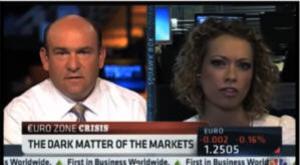The central banks in Europe seem to be more interested in window dressing than fixing the window, and if they don't come up with some real solutions, things could go from bad to worse, observes Gemma Godfrey of The Investment Insight.
As US stocks and the European equity index continue in risk on, risk off flip-flops against a backdrop of disappointing data, market moves seems misplaced. Instead, central bank action is cosmetic, not medicinal; a tool for reassurance, not economic change.
Developments from the recent EU summit are either temporary or limited, and capital remains restricted. However, economic deterioration heats up the pressure for action. Therefore, central banks are damned if they act and damned if they don’t. For sentiment to turn, we need to see signs of stability, as well as support.
Central Bank Action is Cosmetic, Not Medicinal
Central bank action is being met with skepticism, and initial market rallies used as selling opportunities for profit taking. This is because moves are cosmetic and not medicinal, as in the short term they may reassure markets that measures are being taken, but they are of limited effectiveness at significantly boosting growth.
Even Draghi himself, the President of the European Central Bank, argued “price signals (have) relatively limited immediate effect.” They won’t stimulate demand and, by potentially hurting bank profitability, could reduce the incentive to lend—the opposite of the target outcome.
Nevertheless, for the first time, we have seen the ECB cut the benchmark interest rate below 1%. In the same week, the Bank of England announced it will be increasing asset purchases by £50m.
With weak US data and Bernanke already cautious, the pressure will be on to turn "Operaton Twist" into a more traditional waltz. Investors will be hoping the Fed will pump more liquidity into the system instead of "twisting" or neutralizing purchases by selling elsewhere along the yield curve.
Summit Moves Are Limited
The outcome of extensive talks at the EU Summit likewise fueled a "false rally." Spanish government bonds have since returned to hover around the unsustainable 7% level again despite developments. Instead, the three key "achievements" are temporary or limited, as explained below:
- Senior not guaranteed: Investors have been moved higher up the pecking order, and will now be repaid for loans made to Spanish banks before the bailout fund. Being the first in line to get money back is indeed an improvement, but crucially, the risk of loss is still there, and may continue to worry the markets.
- Wishful thinking? The government has been removed from the equation, with bailout funds now able to offer loans to struggling Spanish banks directly. Removing government involvement in bank bailouts to protects sovereign bond yields ignores the possibility investors will continue to view the health of the banks as a driver of economic health.
- Bond buying boost limited: Bailout funds may now buy debt directly from “solvent countries” (read: Italy). However, this is a limited source of demand, and again short-sighted.
Capital Remains Restricted
The size of the problem remains a key concern, and a crucial measure missing from the summit was a substantial strengthening of the "firewalls." At €500bn, the rescue fund is only 20% of the €2.4 trillion combined debt burden of Spain and Italy. The risk that a lack of funding will leave European leaders unable to stop the crisis spreading remains.
Economic Deterioration Heats Up the Pressure for Action
With a backdrop of a deteriorating economic environment, Europe is far from able to grow out of the problem. German manufacturing deteriorated for a fourth consecutive month. Relied upon as a rare source of growth, the outlook is dimming.
European unemployment has reached its highest level since the creation of the euro. This is unlikely to spur spending, and instead put the pressure back on central banks to do something to kick-start economic growth.
Therefore, central banks are damned if they act and damned if they don’t. For sentiment to turn, we need to see signs of stability, as well as support.
Read more from The Investment Insight here...
Related Reading:




















